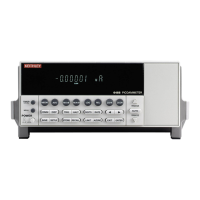Model 6485 Picoammeter Instruction Manual Applications Guide I-7
Here, Z
F
represents the feedback impedance made up of C
F
and R
F
, while Z
S
is the source
impedance formed by R
S
and C
S
. Furthermore,
and,
Note that as C
S
increases in value, Z
S
decreases in value, thereby increasing the noise gain.
Again, at the point where Z
S
= Z
F
, the input noise is amplified by a factor of two.
The maximum value of source capacitance (C
S
) for the lower ranges of the Model 6485
picoammeter is 10,000pF. You can, however, usually measure at higher source capacitance
values by inserting a resistor in series with the picoammeter input, but remember that any
series resistance will increase the voltage burden by I
IN
• R
SERIES
. For example, the range
of resistance listed in Table I-1 will result in voltage burden values in range of 2mV to 2V.
A useful alternative to a series resistor is a series diode, or two diodes in parallel
back-to-back. The diodes can be small-signal types and should be in a light-tight enclo-
sure.
Electrostatic interference and shielding
Electrostatic interference is probably the most common source of error when making low
current measurements. Electrostatic coupling or interference occurs when an electrically
charged object is brought near an uncharged object. At low impedance levels, the effect of
the interference are not noticeable because the charge dissipates rapidly. However, high
resistance materials do not allow the charge to decay quickly, which may result in unstable
measurements. The erroneous readings may be due to either DC or AC electrostatic fields,
so electrostatic shielding will help minimize the effects of these fields.
DC fields can produce noisy readings or undetected errors. These fields can be detected
when movement near an experiment (such as the movement of the person operating the
instrument or others in the immediate vicinity) causes fluctuations on the picoammeter's
display. To perform a quick check for interference, place a piece of charged plastic, such
as a comb, near the circuit. A large change in the meter reading indicates insufficient
shielding.
AC fields can be equally troublesome. These are caused most often by power lines and RF
fields. If the AC voltage at the input is large, part of this signal is rectified, producing an
error in the DC signal being measured. This can be checked by observing the analog out-
put of the picoammeter with an oscilloscope. A clipped waveform indicates a need to
improve electrostatic shielding.
Z
F
R
F
2πfR
F
C
F
()
2
1+[]
-------------------------------------------------=
Z
S
R
S
2πfR
S
C
S
()
2
1+[]
-------------------------------------------------=

